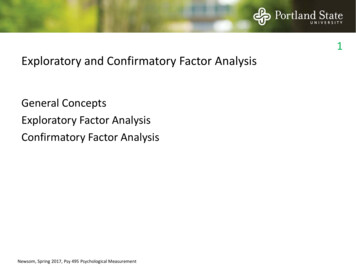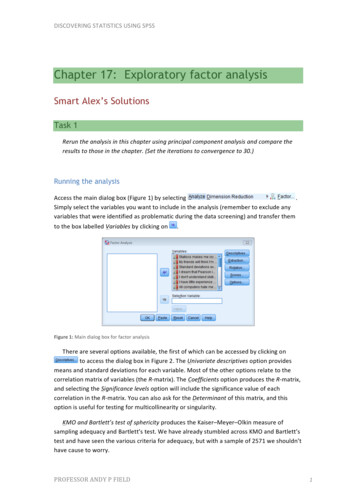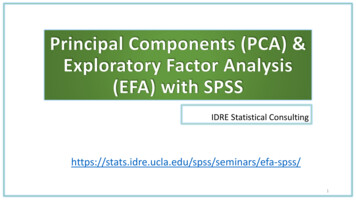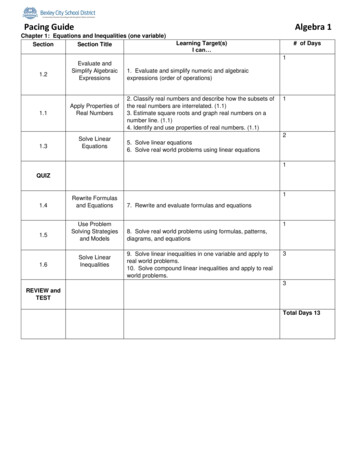
Transcription
Exploratory and Confirmatory Factor AnalysisGeneral ConceptsExploratory Factor AnalysisConfirmatory Factor AnalysisNewsom, Spring 2017, Psy 495 Psychological Measurement1
General ConceptsFactor analysis provides information about reliability, itemquality, and construct validityGeneral goal is to understand whether and to what extentitems from a scale may reflect an underlying hypotheticalconstruct or constructs, known as factorsAn analytic method with high sensitivity to identify problematicitems and assess the number of factorsNewsom, Spring 2017, Psy 495 Psychological Measurement2
General ConceptsIn general, factor analysis methods decompose (or break down)the covariation among items in a measure into meaningfulcomponentsHigher inter-item correlations should reflect greater overlap inwhat the items measure, and, therefore, higher inter-itemcorrelations reflect higher internal reliabilityNewsom, Spring 2017, Psy 495 Psychological Measurement3
4General ConceptsClassical Test Theory (CTT)Observed ScoreXo Newsom, Spring 2017, Psy 495 Psychological MeasurementTrueScoreXt Error Xe
5General ConceptsFactor model concept is analogous to CTTTrue scoreXtFactorObserved scoreXoMeasured variableErrorNewsom, Spring 2017, Psy 495 Psychological MeasurementXeError (measurement residual)
6General ConceptsIn practice, a factor cannot be estimated with one itemShould only be estimated with three or more itemsItems with higher correlation with factor contribute more to themeasureFNewsom, Spring 2017, Psy 495 Psychological MeasurementXXXeee
7General ConceptsItems are referred to as indicatorsRegression slopes between factor and indicators are referred toas loadingsFNewsom, Spring 2017, Psy 495 Psychological MeasurementX1X2X3eee
General ConceptsPatterns of high inter-item correlations among subsets of itemssuggest more than one factor because the items tend to“cluster” togetherAny number of factors might underlie a set of items, up to thetotal number of items (which would imply no commonfactor)Example: set of six items might assess extroversion and opennessNewsom, Spring 2017, Psy 495 Psychological Measurement8
General ConceptsFurr, R. M., & Bacharach, V. R. (2013). Psychometrics: an introduction, second edition. Sage.Newsom, Spring 2017, Psy 495 Psychological Measurement9
General ConceptsWe never know the meaning of the factors, however; we canonly use theory to decide what they mean and then testtheir validityThe factors may be related or not related—correlated ororthogonal (uncorrelated)If those who are extroverted tend to be a little more open, thenthe factors are correlated (contrary to what is suggested bythe table)Newsom, Spring 2017, Psy 495 Psychological Measurement10
Exploratory Factor AnalysisTwo major types of factor analysisExploratory factor analysis (EFA)Confirmatory factor analysis (CFA)Major difference is that EFA seeks to discover the number offactors and does not specify which items load on whichfactorsNewsom, Spring 2017, Psy 495 Psychological Measurement11
12Exploratory Factor AnalysisIn EFA, loadings are obtained for all items related to allfactorsConsistencyof InterestPerseveranceof InterestX1X2X3X1X2X3eeeeeeNewsom, Spring 2017, Psy 495 Psychological Measurement
Exploratory Factor AnalysisThe researcher may discover there is one factor underlying theitems or many factorsItems may be eliminated by the researcher if they do not loadhighlyResearchers choose items that load highly on one factor andlow on other factors to achieve simple structureComposite scale scores often created based on the factoranalysis to be used in further researchNewsom, Spring 2017, Psy 495 Psychological Measurement13
Exploratory Factor AnalysisEFA is available in most general statistical software, such asSPSS, R, SASInvolves several steps and decision pointsDeciding on the number of factorsExtractionRotationNewsom, Spring 2017, Psy 495 Psychological Measurement14
Exploratory Factor AnalysisAn initial analysis called principal components analysis (PCA) isfirst conducted to help determine the number of factors thatunderlie the set of itemsPCA is the default EFA method in most software and the firststage in other exploratory factor analysis methods to selectthe number of factorsPCA is not considered a “true factor analysis method,” becausemeasurement error is not estimated (Snook & Gorsuch,1989)Newsom, Spring 2017, Psy 495 Psychological Measurement15
Exploratory Factor AnalysisPCA gives eigenvalues for the number of components (factors)equal to the number of itemsIf 12 items, there will be 12 eigenvaluesEach component is a potential “cluster” of highly intercorrelated itemsEigenvalues represent the amount of variance accounted for byeach component, but they are not in a standardized metricLarger eigenvalues indicate a more important (and more likelyreal) components or factor, with some merely reflectingunimportant factors or random variationNewsom, Spring 2017, Psy 495 Psychological Measurement16
Exploratory Factor AnalysisThe values sum to the number of items, so if 12 items, thenthere will be 12 eigenvalues that sum to 12The proportion or percentage of (co)variance accounted for byeach factor can be calculated by dividing by the number ofitemsNewsom, Spring 2017, Psy 495 Psychological Measurement17
Exploratory Factor AnalysisFurr, R. M., & Bacharach, V. R. (2013). Psychometrics: an introduction, second edition. Sage.Newsom, Spring 2017, Psy 495 Psychological Measurement18
Exploratory Factor AnalysisThere are several possible rules which may be used forchoosing the number of factors based on eigenvaluesThe usual rule of greater than 1.0 (the Kaiser-Guttman rule)does not seem to work the best (Preacher & MacCallaum,2003)Most use the scree plot and a subjective scree test byidentifying the biggest drop in eigenvaluesThe scree test or a more objective version (Cattell–Nelson–Gorsuch test) seems to work well for identifying the correctnumber of factors (Cattell & Vogelmann, 1977)Newsom, Spring 2017, Psy 495 Psychological Measurement19
Exploratory Factor AnalysisFurr, R. M., & Bacharach, V. R. (2013). Psychometrics: an introduction, second edition. Sage.Newsom, Spring 2017, Psy 495 Psychological Measurement20
Exploratory Factor AnalysisNext steps in an EFA after deciding on the number of factors isto choose a method of extractionThe extraction method is the statistical algorithm used toestimate loadingsThere are several to choose from, of which principal factors(principal axis factoring) or maximum likelihood seem toperform the best (Fabrigar et al., 1999)Newsom, Spring 2017, Psy 495 Psychological Measurement21
Exploratory Factor AnalysisAnd factor rotationFactor rotation is a mathematical scaling process for theloadings that also specifies whether the factors arecorrelated (oblique) or uncorrelated (orthogonal)Usually no harm in allowing factors to correlateIf the factor correlation is zero, then the same as orthogonalOrthogonal rotation makes a strong assumption that the factorsare uncorrelated, which probably is not likely in mostapplicationsNewsom, Spring 2017, Psy 495 Psychological Measurement22
Exploratory Factor AnalysisSweeney, J. C., & Soutar, G. N. (2001). Consumer perceived value: The development of a multiple itemscale. Journal of retailing, 77(2), 203-220.Newsom, Spring 2017, Psy 495 Psychological Measurement23
Confirmatory Factor AnalysisConfirmatory factor analysis (CFA) starts with a hypothesisabout how many factors there are and which items load onwhich factorsFactor loadings and factor correlations are obtained as in EFAEFA, in contrast, does not specify a measurement model initiallyand usually seeks to discover the measurement modelIn EFA, all items load on all factorsIn CFA, most researchers start with a model in which items loadon only one factor (simple structure)Newsom, Spring 2017, Psy 495 Psychological Measurement24
25Confirmatory Factor AnalysisConsistencyof InterestPerseveranceof InterestX1X2X3X1X2X3eeeeeeNewsom, Spring 2017, Psy 495 Psychological MeasurementDuckworth, A. L., & Quinn, P. D. (2009). Development and validation of theShort Grit Scale (GRIT–S). Journal of personality assessment, 91(2), 166-174.
Confirmatory Factor AnalysisA test is computed to investigate how well the hypothesizedfactor structure fits with the dataThe fit test seeks to find a non-significant result, indicating goodfit to the dataNewsom, Spring 2017, Psy 495 Psychological Measurement26
Confirmatory Factor AnalysisThe model fit is derived from comparing the correlations(technically, the covariances) among the items to thecorrelations expected by the model being testedMathematically, certain models imply certain correlations, e.g.,if one-factor model, items should be highly correlated, items that donot correlate highly will lead to a poor fit for a one factor modelIf model specifies that two factors are uncorrelated, then the model willnot fit well if items from one factor tend to be correlated with itemsfrom another factorNewsom, Spring 2017, Psy 495 Psychological Measurement27
Confirmatory Factor AnalysisYou may hear about many fit indices, so here are somecommon examples:Chi-square, χ2 lower values indicate better fitRMSEA, lower values indicate better fit ( .06)SRMR, lower values indicate better fit ( .08)Comparative Fit Index, higher value indicate better fit ( .95)Tucker-Lewis Index, higher value indicate better fit ( .95)Newsom, Spring 2017, Psy 495 Psychological Measurement28
Confirmatory Factor AnalysisIf the model does not fit well, it can be altered and retestedMany possible loading structures can be specified by the userand any item can load on multiple factors if desiredThe more changes made, the more the researcher may becapitalizing on chance, running the risk of Type I errorsNewsom, Spring 2017, Psy 495 Psychological Measurement29
30Confirmatory Factor AnalysisConsistencyof InterestPerseveranceof InterestX1X2X3X1X2X3eeeeeeNewsom, Spring 2017, Psy 495 Psychological MeasurementDuckworth, A. L., & Quinn, P. D. (2009). Development and validation of theShort Grit Scale (GRIT–S). Journal of personality assessment, 91(2), 166-174.
Confirmatory Factor AnalysisThe differences between EFA and CFA are often overstatedDespite their names, both can be used in an exploratorymannerCFA models can be modified if the model does not fit wellEFA is sometimes used by researchers even though they have a welldeveloped idea about the factor structure and wants to confirm itBoth methods are based on discovering number of underlyingfactors for a set of items and estimating how strongly theyrelate to the factorsNewsom, Spring 2017, Psy 495 Psychological Measurement31
Confirmatory Factor AnalysisBoth methods of factor analysis are sensitive psychometricanalysis that provide information about reliability, itemquality, and validityScale may be modified by eliminating items or changing thestructure of the measureEither method may be used as a preliminary step to evaluate ameasure or set of subscales that will be computed and usedin later researchNewsom, Spring 2017, Psy 495 Psychological Measurement32
Confirmatory Factor AnalysisSpecialized software usually required (e.g., Amos, Mplus,LISREL, EQS, the R package lavaan)EFA procedures usually available in general statistical softwarepackages like SPSS, SAS, Stata etc.Newsom, Spring 2017, Psy 495 Psychological Measurement33
Confirmatory Factor AnalysisCFA is part of a larger analysis framework, called structuralequation modeling (SEM), which combines CFA with pathanalysis (regression slopes)SEM can use factors (or “latent variables”) in regression analysisto predict other variables or be predicted by other variables,with the advantage of estimating and eliminatingmeasurement error from correlation and regressionestimatesNewsom, Spring 2017, Psy 495 Psychological Measurement34
Confirmatory Factor AnalysisNewsom, J.T., Shaw, B.A., August, K.J., & Strath, S.J. (2016). Physical activity–related social control and socialsupport in older adults: Cognitive and emotional pathways to physical activity. Journal of Health Psychology, 116. Published online July 29, 2016: DOI: 10.1177/1359105316656768Newsom, Spring 2017, Psy 495 Psychological Measurement35
Confirmatory Factor AnalysisBentler, P. M., & Lee, S. Y. (1979). A statistical development of three‐mode factor analysis. British Journal ofMathematical and Statistical Psychology, 32(1), 87-104.Newsom, Spring 2017, Psy 495 Psychological Measurement36
Jul 29, 2016 · Exploratory Factor Analysis An initial analysis called principal components analysis (PCA) is first conducted to help determine the number of factors that underlie the set of items PCA is the default EFA method in most software and the first stage in other exploratory factor










